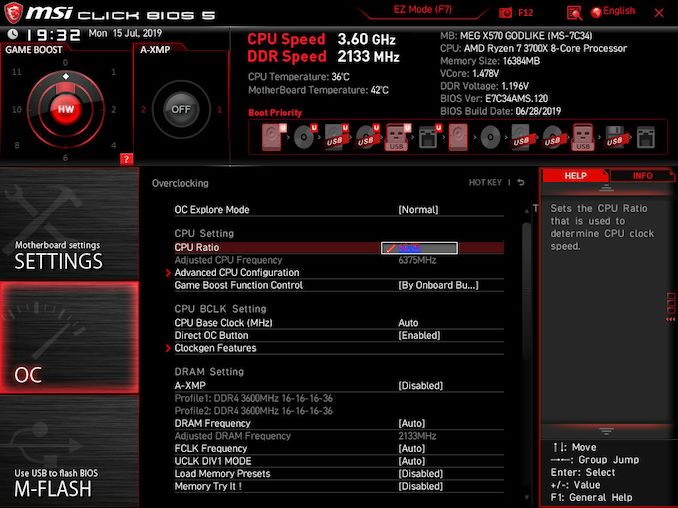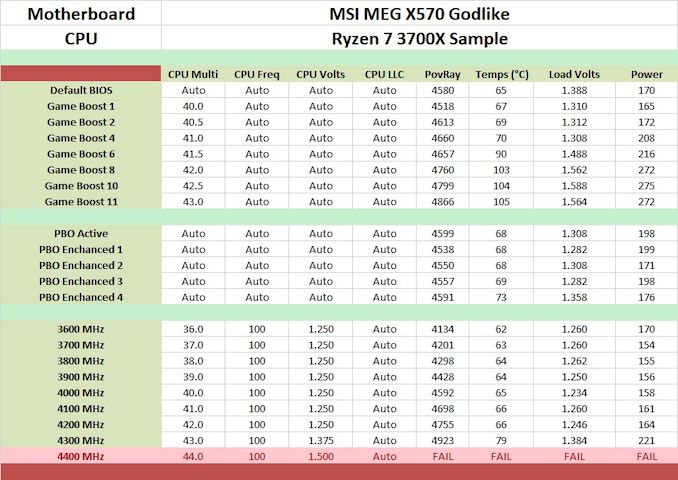The MSI MEG X570 Godlike Motherboard Review: Thor's Flagship
by Gavin Bonshor on August 28, 2019 12:00 PM EST- Posted in
- Motherboards
- AMD
- MSI
- 10G Ethernet
- Ryzen
- PCIe 4.0
- Ryzen 3000
- X570
- X570 Godlike
- MEG
Overclocking Ryzen 3000
Experience with the MSI MEG X570 Godlike
Overclocking with the Ryzen 3000 series hasn't exactly titillated users since its launch with there not being much headroom available. The biggest issue with this boils down to all-core overclocks being limited by the worst core of the chip. and the new 7 nm processors running quite warm. To get the best experience and results with the Ryzen 3000, users with good quality AIOs and custom water cooling yields the best outcome, and even with voltages of 1.375 V, these chips can run a little too warm for comfort.
The MSI Click BIOS 5 firmware is familiar to us and throughout the different chipsets including X399, X470, and Z390, the MSI MEG X570 Godlike uses the same design layout and setup. Within the OC section of the firmware, users can alter important settings such as the CPU ratio which can be changed in steps of 0.25 MHz, with relevant settings including CPU VCore, CPU Base Clock, and even FCLK frequency. Deeper into the firmware is settings to set the load line calibration (LLC) to a more aggressive or liberal profile, as well as all the Precision Boost Overdrive (PBO) settings.
The three main settings that PBO works from include package power tracking (PPT), thermal design current (TDC), and the electrical design current (EDC). All three of these can be set within the firmware under the advanced section of the Precision Boost Overdrive menu, although MSI has included four different PBO profiles for users to select from. The higher the setting, the higher the thermal and power draw will be, and it may not necessarily matter if a sub-par cooler is installed; it's noted that Ryzen 3000 processors work better when they are cooler.
There are seven different MSI Game Boost profiles to select from and users can access them via the dial at the bottom of the board, or through the firmware itself. The Game Boost profiles within the firmware can be accessed through the dial in the top left-hand corner. These profiles range from 4.0 GHz through to 4.3 GHz, and we've tested each of them below.
Overclocking Methodology
Our standard overclocking methodology is as follows. We select the automatic overclock options and test for stability with POV-Ray and OCCT to simulate high-end workloads. These stability tests aim to catch any immediate causes for memory or CPU errors.
For manual overclocks, based on the information gathered from the previous testing, starts off at a nominal voltage and CPU multiplier, and the multiplier is increased until the stability tests are failed. The CPU voltage is increased gradually until the stability tests are passed, and the process repeated until the motherboard reduces the multiplier automatically (due to safety protocol) or the CPU temperature reaches a stupidly high level (105ºC+). Our testbed is not in a case, which should push overclocks higher with fresher (cooler) air.
Overclocking Results
As it currently stands, MSI's Game Boost overclocking profiles need quite a bit of refinement, something they have informed us that these will be rectified with a new firmware revision; we will test this when we receive the board back from MSI. The issue with these is CPU VCore, or in a nutshell, too much of it which cross the board into the unsafe territory of the Ryzen 3000 processors safety limits; both in CPU VCore and in temperature. When we activated PBO and MSI's preset profiles for this, it didn't make much of an impact over the stock settings, which seems to be a reoccurring issue so far across the range of models we have tested so far.
Manually overclocking the MSI MEG X570 Godlike proved very fruitful and we managed to hit what seems to be the limits of our Ryzen 7 3700X testbed CPU with an overclock of 4.3 GHz all-cores with a CPU VCore of 1.35 V, which seems to be the brick wall for our processor. Even with a CPU VCore of 1.50 V, we couldn't get 4.4 GHz to remain stable when any kind of semi-intensive load was placed on the processor, although we did manage to boot into Windows 10 without fanfare with these settings. The performance wasn't throttled in POV-Ray throughout each of the frequencies tested and once the temperature limit of 110ºC is exceeded, the system will safely shut down. From 3.6 to 4.2 GHz, we managed to do this with a set CPU VCore of 1.250 V which did fluctuate slightly under load under the auto LLC setting. It is safe to say that the MSI MEG X570 Godlike doesn't have a VDroop issue and even at 4.3 GHz, a set CPU VCore of 1.375 resulted in a maximum load voltage of 1.384 V which isn't too far off the mark.













116 Comments
View All Comments
imaheadcase - Wednesday, August 28, 2019 - link
I mean it is cool and nice features, but $700 for a mobo when its the core component of a system..and also the one that is easiest to get outdated faster is kinda silly. I suppose the argument is that if buying it not really going to care about costs anyways. hehegoatfajitas - Wednesday, August 28, 2019 - link
Yeah, especially when there are alot of motherboards that are very nearly as good for a lot less. These $700 models probably overclock like crazy, but it's just not as needed as it was 10+ years ago. CPU is almost never the bottleneck anymore so overclocking it is kinda moot.Smell This - Wednesday, August 28, 2019 - link
Odd in that MSI CEO Charles Chiang dumped-on AMD 8 months ago --- then proceeds to market $700+ SP3 motherboards ...
https://www.tomshardware.com/news/msi-ceo-intervie...
Samus - Wednesday, August 28, 2019 - link
I remember that article and was actually thinking the same thing. What honor is there in stabbing someone in the back then patting them on the back 8 months later?Peter2k - Thursday, August 29, 2019 - link
Because Gigabyte and Asus have 700$ boards with they're gaming brands?WaltC - Thursday, August 29, 2019 - link
Yes, and funny thing is....look what they're doing to retrofit their cheap x370/x470 motherboards to Zen 2...;) Sort of puts him in the "I don't know what I'm saying sometimes" category, eh? Too funny!ballsystemlord - Thursday, August 29, 2019 - link
I just read the article and can't find a single stab. He said only that AMD did not have good support a few years ago. Such a statement is either fact or fiction, and if fact, then totally benign.Point out to me the correct position in the article if I'm wrong.
Smell This - Tuesday, September 3, 2019 - link
MSI and **Chuckles** abandoned AMD -- not the other way around. Fair-Weather Chuck took his payola from Chipzillah and scooted, leaving AM2/AM3/AM4 in the wind (until he saw the $$$).It's been downhill for MSI since the 790FX K9A2 Platinum ...
Sweetbabyjays - Wednesday, August 28, 2019 - link
"overclock like crazy" I know right! Going from 4.0 to 4.2 GHz is pretty crazy. Totally worth the extra $450 you're paying.Seriously for this price you're better off getting a 9900k and a high end z390 board if you're fine with 8c/16t. Overclock to 4.8GHz on all cores and call it a day for same price as just the x570 motherboard. A 9900k at 4.8GHz is better than any 8c/16t AMD CPU in literally every single scenario.
Tunnah - Wednesday, August 28, 2019 - link
So you'd settle for a more power hungry CPU, with a motherboard with less future proofing, less expansion, and less features, just for the few percent difference in performance ?